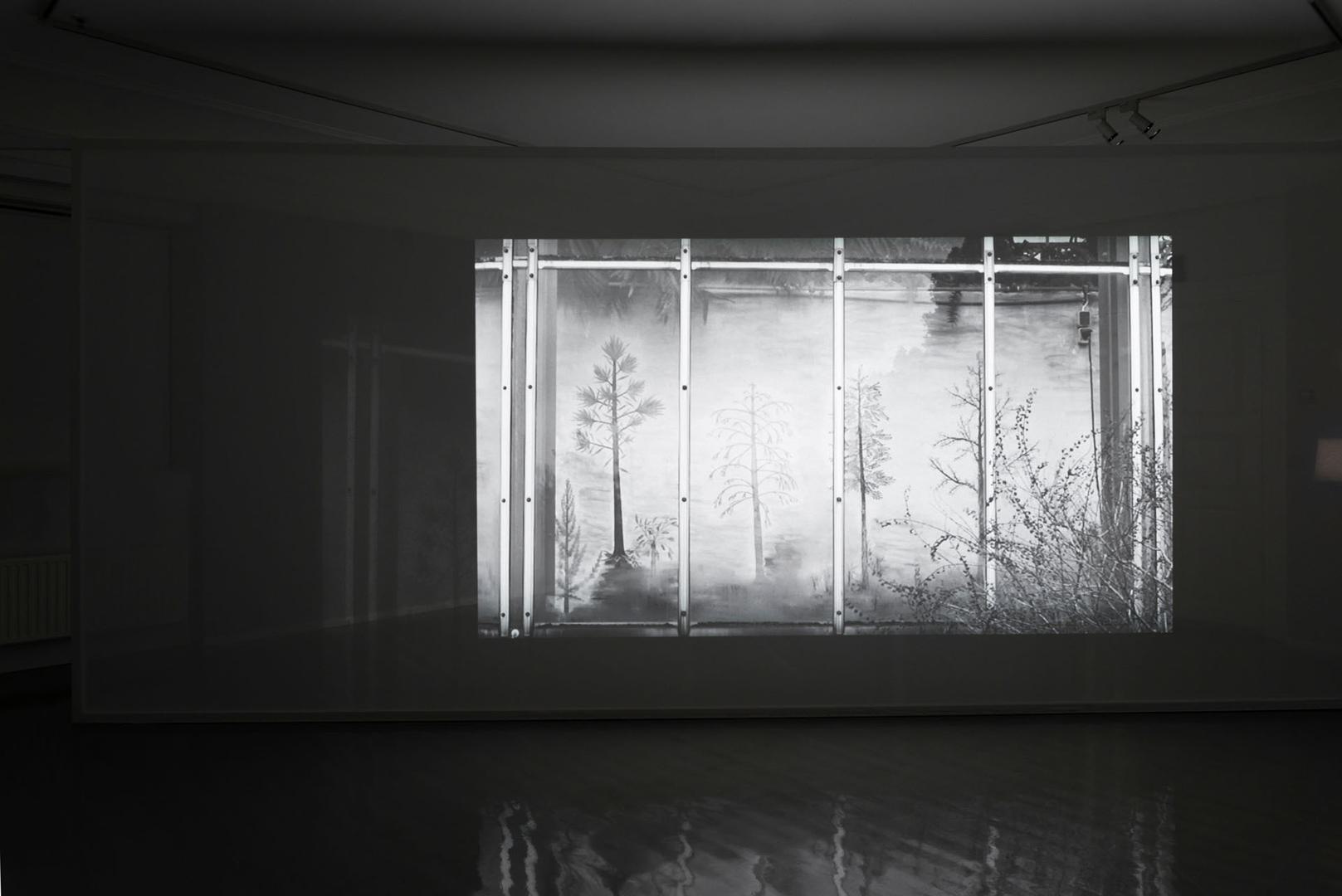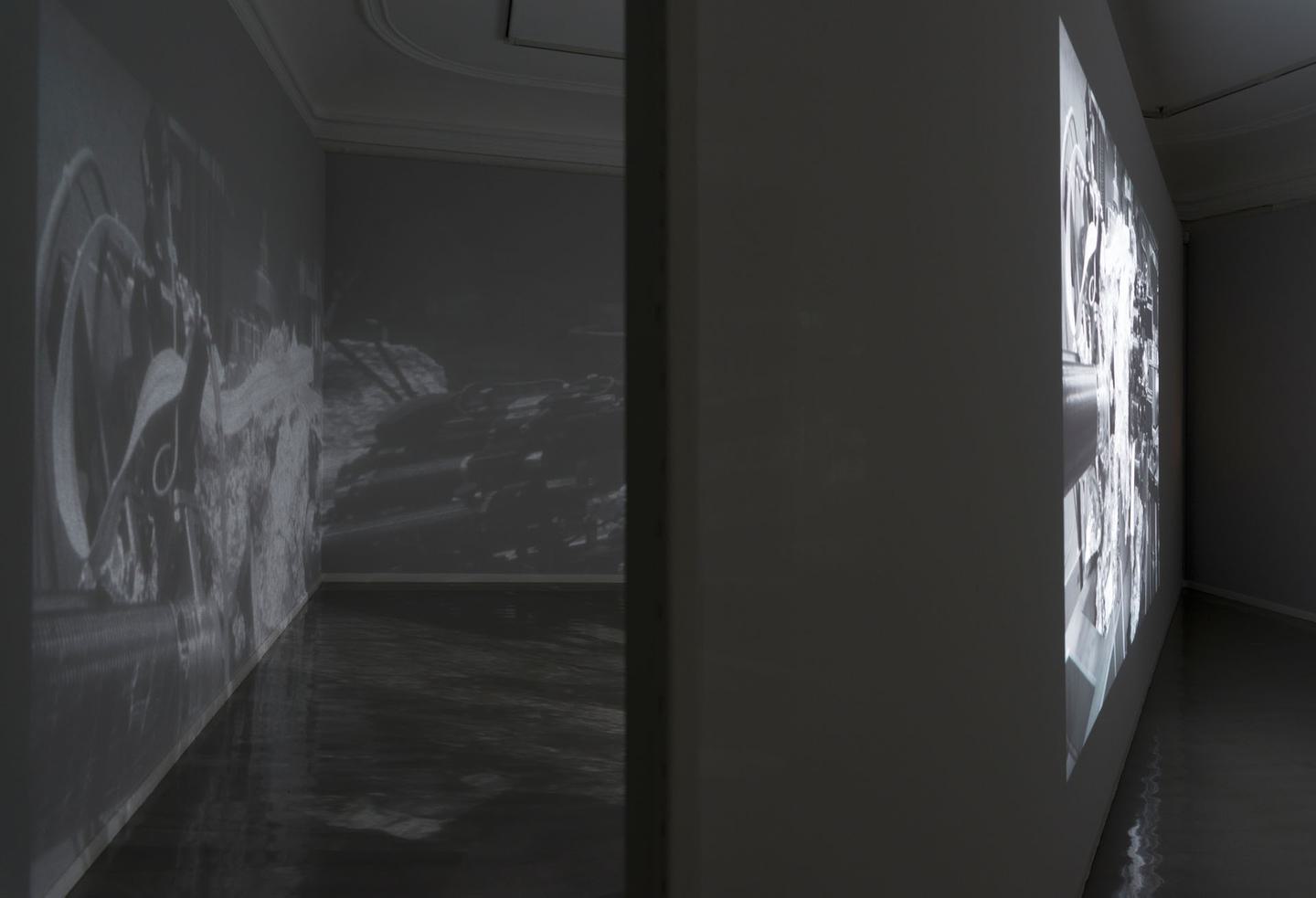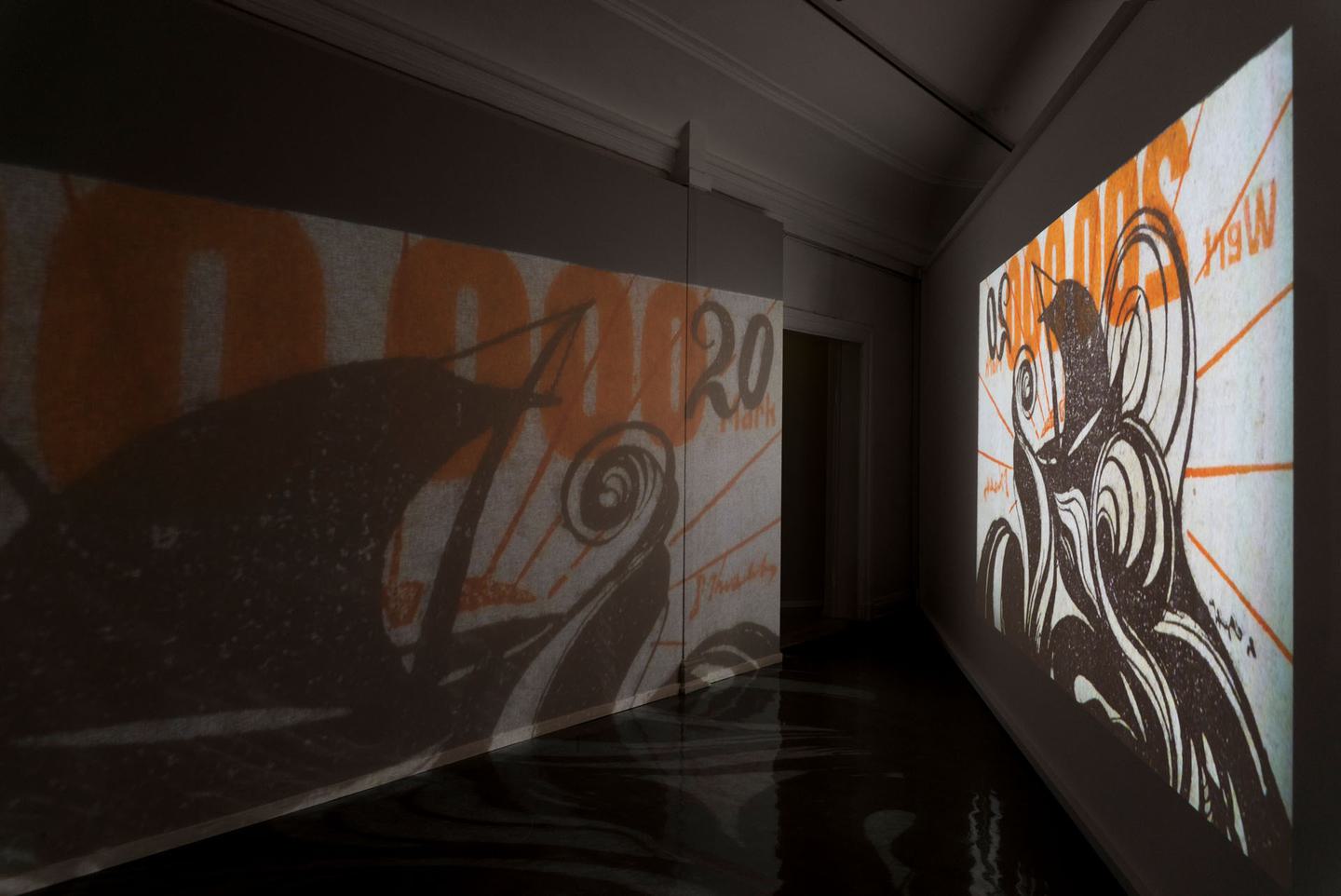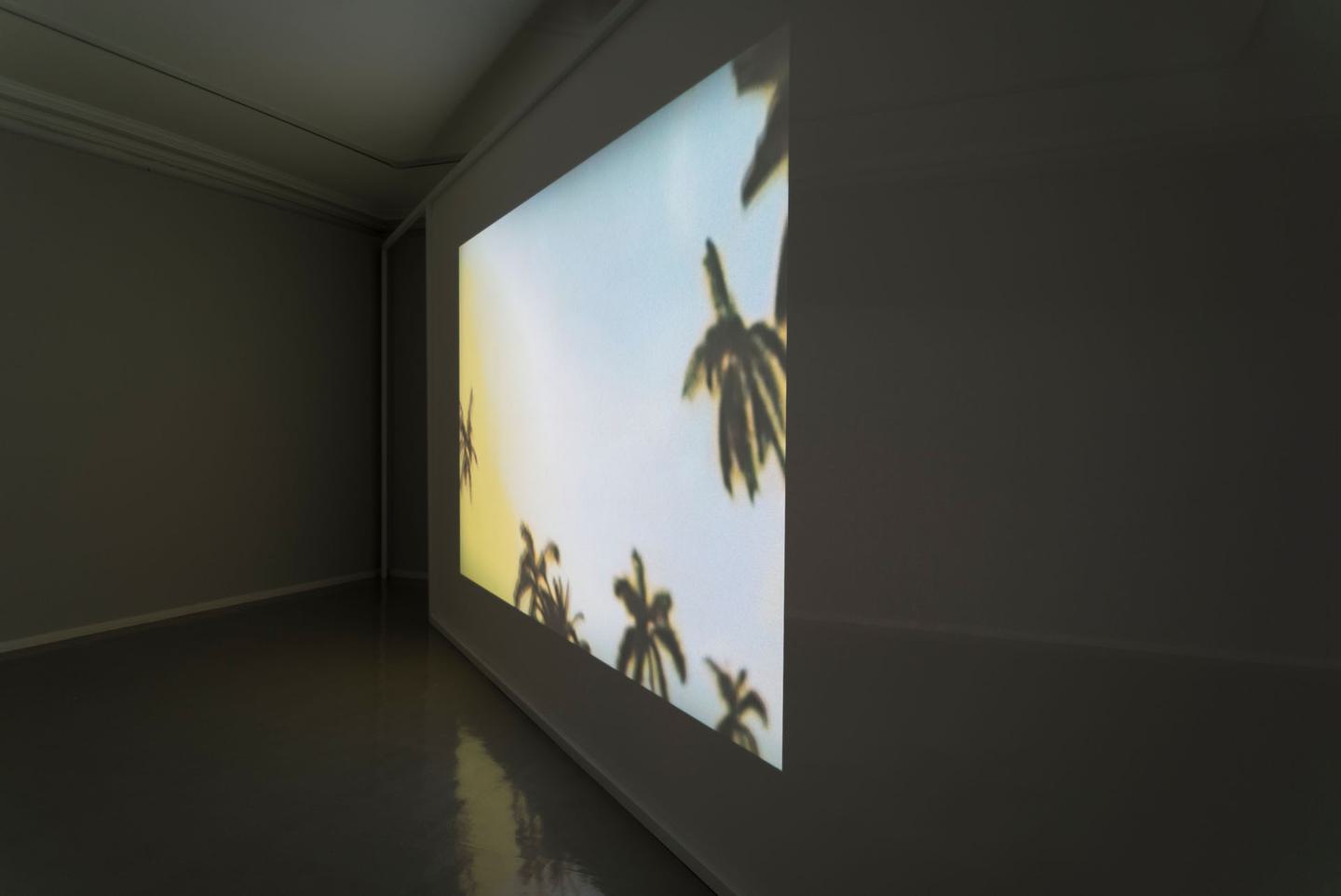– installation in progress.
Lina Selander
Repeat After Me

Lina Selander, Repeat After Me, 2017
Oslo Kunstforening is proud to start off the new year with a solo presentation by Lina Selander.
Lina Selander is one of Sweden's most groundbreaking moving image artists. Her films and installations are often based on historical breakpoints – a liminal space in which a system or a physical space has collapsed and something new is taking shape; the transition from analogue image making to digital, the collapse of political or economic systems. Each work consists of a pictorial world woven from a mix of historical and fictional observations.
Selander’s artistic work revolves around a fascination with the phenomena and technologies that enable image production and documentation. Her work returns to the question of image as memory, imprint and representation. The exhibition presents three video works made in collaboration with Oscar Mangione. This is Lina Selander’s first solo exhibition in Oslo.

Lina Selander, Repeat After Me, 2017
Silphium, 2014
HD video in b/w, sound, 22:00 min
With Oscar Mangione
Produced by Kunsthall Trondheim. Thanks to Jon Anders Risvaag, the Science Museum, NTNU, Trondheim.
In the first sequences of the film a story is told about the ancient, now extinct, plant Silphium. The plant grew on the coast outside the North African town Cyrene situated in today’s Libya. Cyrene was one of the main towns in the Greek colony, built upon of a settlement of Greeks from the over populated island of Thera in 630 BC. The plant was famous for its medical usage (it was used as a contraceptive and abortifacient) and for its richness in flavor, which made it the base of the colony’s export. Its importance for the economic wealth was so crucial that the image of Silphium was imprinted on coins. When exploitation of the plant led to extinction, the city declined. As is often the case in Selander’s works, the film builds on layers of images and meaning, layers that link history and pre-history to contemporary society, and in which nature as a prerequisite for life, is one of the focal points. The human strives for development and expansion, the desire for control over nature, and above all – visual control, depiction and surveillance, is always met by another contradicting force. Nature looking back at us, with an empty stare – a reoccurring image in the film.
In Silphium this double movement of visual and earthly mastery is first expressed in a shot of the famous 16th century painting The Ambassadors by Hans Holbein. The ambassadors are depicted together with the emblems of wealth and superiority of the countries they are the representatives for. A contradicting image is hidden until you view the painting from a special angle, but when you do a human skull becomes visible, the sign of mortality. Selander lets the image oscillate in and out of visibility; the painted image emerges as in a rupture of light in the dark whilst mumbling voices count – numbers, years maybe. The sound fragment is a loan from Chris Marker’s 1962 film La Jetée – another important point of reference.
The references to Holbein and Marker are subtle points of departure in the film, as is the history of Silphium. From these points the film unfolds in an essayistic narrative, in which the artist make use of image material and sound from different sources – her own footage and still images, quotes and archive material. The Stasi archive and museum in Berlin as well as the Museum of Natural History and Archaeology in Trondheim have been important sources. A deep interest in the notion of image as memory, imprint, representation and surface is at the core of the work.
– Helena Holmberg, Kunsthall Trondheim (2014)

Lina Selander, Repeat After Me, 2017
The Offspring Resembles the Parent, 2015
HD video in color, sound, 13:44 min
With Oscar Mangione
With support from Moderna Museet, Stockholm and Microhistories, Konstfack and The Swedish Research Council.
The Offspring Resembles the Parent was, like Silphium, made in collaboration with Oscar Mangione. The title is based on Aristotle’s Politics, in which he argues that money increasing at interest is the most unnatural mode of getting wealthy, since, unlike livestock and crops, money cannot breed as it “exists not by nature but by law”. Both works relate to the observation that memory is inextricably connected with economy – in the sense of capital that we manage or hand down. Etymologically, the word stems from the Greek goddess Mnemosyne, protector of memory, language and recall.
In Latin translation, we have 'monere' (to remind), which later became the root for both 'money' and 'muntze', the stem for the Norwegian word 'mynt' (coin). The starting point of the film is the emergency money printed in the 1920s, banknotes used during times of crisis and inflation, or for enclaves without a set structure or definite borders, such as ghettos, concentration camps or colonies. The meticulously designed notes are often visually dramatic, with propagandist messages in word and image. Engaging the veritably cinematic qualities of the delicately colored colonial notes, Selander and Mangione conjure up a bygone era, one in which a project disastrously helped lay the foundations for our own welfare society. “Colonialism as a vehicle for modernism”, as Hamid Dabashi (Professor of Iranian Studies and Comparative Literature at Columbia University in New York City) puts it. The work contemplates on fictive economies, dormant power, blind subordination and a hyperinflation of values – human and monetary.
– Lena Essling, Excavation of the Image, Moderna Museet (2015)

Lina Selander, Repeat After Me, 2017
Ceremonin, 2016
HD video in color and b/w, sound, 16:18 min
With Oscar Mangione
Language has unmistakably made plain that memory is not an instrument for exploring the past, but rather a medium. It is the medium of that which is experienced, just as the earth is the medium in which ancient cities lie buried. He who seeks to approach his own buried past must conduct himself like a man digging. Above all, he must not be afraid to return again and again to the same matter; to scatter it as one scatters earth, to turn it over as one turns over soil. For the ‘matter itself’ is no more than the strata which yield their long-sought secrets only to the most meticulous investigation. That is to say, they yield those images that, severed from all earlier associations, reside as treasures in the sober rooms of our later insights […]
Walter Benjamin
The starting point of the film «Ceremonin» shows the image from the title page of Olof Rudbeck the Elder’s Atlantica from 1679, were Rudbeck tears off a piece of earth’s soft crust to reveal Sweden as the sunken Atlantis. This marvel of non-specialization and heterogeneous connections, is an archaeological novel largely based on speculative etymologies and correspondences written during the era of the Swedish Empire. And in a similar audacious manner, freed from reality’s hold, in layer upon layer of image, text and sound , like abandoned or yet to be built cities, identities, histories and places appear and disappear: Tutankhamen’s crypt and unbroken seal, Bredäng (suburb of Stockholm where the artists live), the strange entrance to the old Stasi headquarters in Berlin, other places, tombs and prisons, all connected by subterranean passages through which an alien time runs; incompatible, turning endlessly into itself.
[…] one can think of it in terms of a search for some kind of hidden ideogram or pictogram that takes place in the editing process and that guides a gaze that edits. There is something like a text-ghost contained in the visual, a sign-like entity that cannot completely manifest itself. The image lingers in front of the viewer, waiting, creating tension on the surface in an unfolding process of (pseudo)revelation where every image is preceded and is followed by another image.
Walter Benjamin, Excavation and Memory, Selected Writings, Vol. 2, part 2 (1931-1934), oversatt til engelsk av Rodney Livingstone.
– Lina Selander in The Touch of the Reel: A Conversation between Lina Selander, Oscar Mangione and Axel Andersson, Microhistories, published by Konstfack University College of Arts, Crafts and Design, Stockholm, 2016
Bio
Lina Selander (b. 1973) lives and works in Stockholm. Recent solo exhibitions have taken place at Iniva (Institute of International Visual Arts), London, 2015; Moderna Museet, Stockholm, 2015; VOX - Centre de l'image contemporaine, Montréal, 2015; Index - The Swedish Contemporary Art Foundation, Stockholm, 2011. She has participated in international group exhibitions such as the Kiev Biennale 2015; Seoul Media City Biennale 2014; Haus der Kulturen der Welt in Berlin, 2014; Manifesta 2012 in Genk, Belgium and Bucharest Biennale 2010. Lina Selander held a solo show at Kunsthall Trondheim in 2014. She represented Sweden at the Venice Biennale in 2015.